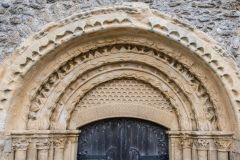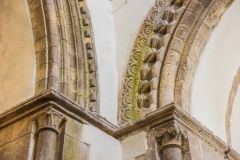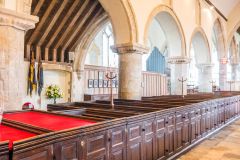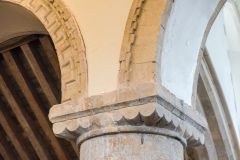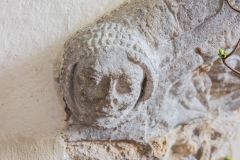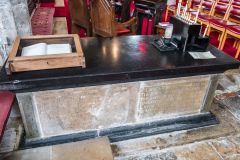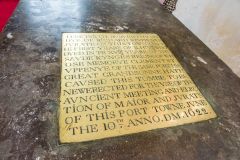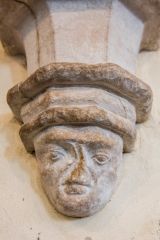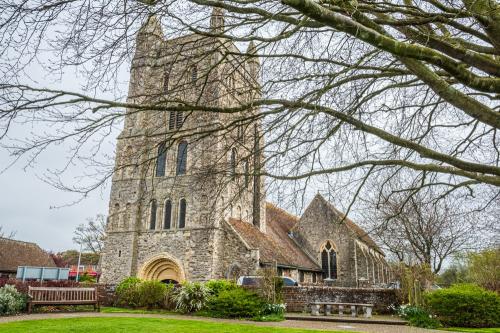
New Romney's parish church, dedicated to St Nicholas, dates to the early years of the 12th century, when it was erected on the banks of a busy harbour. The harbour is gone, destroyed in a storm that shifted the course of the River Rother in 1287, and the town now lies well inland from the coast.
History
That early Norman building was erected under the patronage of Oda, William the Conqueror's half-brother and Archbishop of Canterbury. That Norman building consisted of the present nave and flanking aisles. It was built of Caen stone, favoured by Norman builders, and was probably constructed by masons from Normandy.
The church was enlarged in the 13th and 14th centuries with the addition of a chancel and a pair of side chapels. In the course of enlarging the building, the roof was raised, with the result that the clerestory windows now incongruously sit inside the nave.

The chancel arch was inserted in the 14th century, but you can still see earlier Norman arcading above it.
The superb west tower was begun in the Norman period with two stages, but three additional stages were added in the 13th and 14th centuries. The rounded west tower door probably formed the original nave entrance, but it was moved to its present location at a later date. The tower is now linked to the nave by a 1662 wooden screen.
The sanctuary is flanked by chapels dedicated to Our Lady (north side) and St Stephen (south side). Each chapel has its own altar, piscina, and triple sedilia.

St Stephen's Chapel
In St Stephen's Chapel is the table tomb of Richard Stuppeny, who died in 1526. After Stuppeny's death it became a local tradition to gather at his tomb to elect local Jurats and the Mayor of New Romney. This custom lasted until 1885.
On the south wall of St Stephen's Chapel is a plaque commemorating Isaac Warquin, a Huguenot doctor who came to New Romney from St Quentin, in France, to escape religious persecution in 1689.
The window in the south wall of this chapel depicts the passengers and crew of the sailing ship Northfleet, which sank off Dungeness in 1873.
In the east wall of the chapel is a small window. Speculation is that the window was linked to an anchorite's cell attached to the church, but this would be a peculiar location for such a cell and no records of an anchorite exist.

Lady Chapel
In the Lady Chapel (north side of the sanctuary) is a 1610 memorial brass to Thomas Smyth. The inscription reads, 'Here lyeth buried ye body of Thomas Smyth, one of the Jurats of this town of New Romney with Mary his wife and Elizabeth and Mary, daughters, who after he had lived religiously peaceably and liberally LXVIII years departed this life the 3rd day of January 1610.'
Set into the floor is an earlier brass to Thomas Lamberd, who died in 1510. Lamberd's rhyming epitaph reads:
Of yo[ur] charity pray for me
Thomas Lamberd of Romeney
Which died the XXIII day of August
In likewise so alle ye must
For death is sure to all mankind
Therefore have my soul in mind
Which ended MDX
Years of him ye died for all men.

An even earlier brass is in the floor of the north aisle. Only the escutcheon remains of a memorial to William Holyngbroke, who died in 1375. The inscription is written in Old French and translates as,
'Pray for the soul of William Holyngbroke who departed this life on the 18th day of October in the year of Our Lord 1375.'
One feature of the Holyngbroke is unique in Britain. The inscription uses the word 'DEVIA' as a shorthand for 'departed this life'. This inscription is not found anywhere else in the country.
The church narrowly escaped the worst of the Victorian penchant for 'restoration' that would have swept away so many of its medieval features. Refurbishment began in 1878, but the Society for the Protection of Ancient Buildings stepped in.

Led by William Morris, the Society fought a PR campaign that stopped the proposed rebuilding works. As a result, St Nicholas' Church remains a wonderful example of Norman Romanesque and medieval Gothic architecture.
Visiting
The church was open when we visited and, as far as we can determine, is regularly open to visitors. There is parking along Church Lane and a pay and display car park directly opposite the church on Church Road.
About New Romney, St Nicholas Church
Address: Church Lane,
New Romney,
Romney Marsh,
Kent,
England, TN28 8EU
Attraction Type: Historic Church
Location: At the junction of Church Lane and Church Road. Parking along Church Lane or in the pay and display car park on Church Road.
Website: New Romney, St Nicholas Church
Location
map
OS: TR065247
Photo Credit: David Ross and Britain Express
POPULAR POSTS
HERITAGE
 We've 'tagged' this attraction information to help you find related historic attractions and learn more about major time periods mentioned.
We've 'tagged' this attraction information to help you find related historic attractions and learn more about major time periods mentioned.
Find other attractions tagged with:
NEARBY HISTORIC ATTRACTIONS
Heritage Rated from 1- 5 (low to exceptional) on historic interest
Romney, Hythe & Dymchurch Railway - 0.6 miles (Family Attraction) ![]()
Old Romney, St Clement's Church - 1.9 miles (Historic Church) ![]()
St Mary in the Marsh Church - 2 miles (Historic Church) ![]()
Lydd, All Saints Church - 2.7 miles (Historic Church) ![]()
Dymchurch Martello Tower - 3.7 miles (Historic Building) ![]()
Dungeness Old Lighthouse - 5.2 miles (Historic Building) ![]()
Fairfield, St Thomas Becket Church - 6.2 miles (Historic Church) ![]()
Appledore, St Peter & St Paul Church - 7.2 miles (Historic Church) ![]()
Nearest Holiday Cottages to New Romney, St Nicholas Church:
Littlestone-on-Sea, Kent
Sleeps: 8
Stay from: £703 - 2583
More self catering near New Romney, St Nicholas Church
